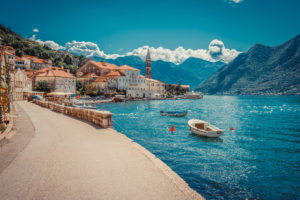Dramatic Adriatic coastline, ancient towns have attracted investors to this tiny Balkan nation
Montenegro – Just 12 years after declaring its independence, Montenegro is gaining traction in its ambitious goal of becoming one of the dominant players in the Balkans luxury-resort business.
The tiny country’s first celebrity-endorsed golf course—designed by Gary Player—is scheduled to launch next month as part of Luštica Bay, Montenegro’s biggest resort development. That same day, Luštica Bay’s developer, Egyptian firm Orascom Development Holding, is planning to open the resort’s first five-star hotel, the Chedi Luštica Bay, with prices for its 111 rooms and suites starting at €400 (around $468) a night.
The projects will join the dozens of hotels that have opened since 2006 in Montenegro, as part of government plans to increase hotel beds in coastal areas, where the vast majority of tourism takes place, some 194% to 100,000 by 2020. Several major resorts are under construction and partly operative, with another half dozen on the drawing board.
Foreign investors who showed up early are cashing in. In 2007, for example, an investment group including Peter Munk, the Canadian founder of mining company Barrick Gold Corp. , paid $26 million for a 99-year lease on a rundown, government-owned naval site on the Bay of Kotor. Other members of the group included Russian metals tycoon Oleg Deripaska and banking-family scions Nathaniel and Jacob Rothschild.
The group turned the development named Porto Montenegro into a marina for superyachts and a luxury village, complete with shops, restaurants, an international boarding school and a five-star hotel managed by Taiwanese company Regent. The entire resort was acquired in 2016 by the Investment Corporation of Dubai, the principal investment arm of the Dubai government, for an undisclosed sum.
Porto Montenegro’s 290 apartments have sold out. “Prices have risen from around €4,000 per square meter to around €7,500 per square meter over the period of the development,” says John Stephens, sales manager of Porto Montenegro.
Montenegro, which means black mountain, is benefiting from its dramatic, craggy Adriatic coastline, often described as Europe’s southernmost fiord, and Unesco-listed Bay of Kotor, pinned into the shape of a butterfly by soaring granite peaks and lapping the ancient towns of Kotor and Perast.
The growth of its resort industry is a case study in how governments can stoke foreign investment with business-friendly policies. Montenegro, a candidate to join the European Union, has adopted the euro as its sole legal tender, facilitating investments and helping to control inflation in recent years. Its foreign-trade law offers significant tax exemptions to overseas investors that open local companies.
“The government of Montenegro has made developers and investors feel appreciated,” said Ahmet Erentok, chairman of Azmont Holdings, which is developing Portonovi, a €830 million resort that started delivering its first apartments last year and will welcome superyachts later this summer.
Other countries that were part of the former Yugoslavia have tried to cash in on their natural charms, but budget-friendly beach destination Croatia, for example, has lacked Montenegro’s laser focus on elite tourism and the yachting community. “That’s where it’s believed Montenegro can surpass Croatia in terms of the quality of its accommodation and tourism infrastructure, as well as the traveler experience,” said Joe Stather, associate director at CBRE.
Some critics, including the United Nations culture and heritage organization, Unesco, have warned that excessive development could spoil the natural beauty drawing tourists to visit in the first place. The agency threatened to strip Kotor’s listing last year citing damage done by real-estate construction, uncontrolled tourism and the docking of large cruise ships.
Montenegro’s tourism revenue was €846.4 million last year, or around 22% of GDP, according to the World Travel and Tourism Council. It is expected to exceed €900 million this year, making it one of the fastest-growing destinations in Europe.
Only 43% of hotel rooms were occupied on average in 2017, according to CBRE data, although occupancy rates have climbed from 29.3% in 2007. Revenue per average room was also unimpressive last year at $36.70, after creeping up from a low of $24.93 in 2010. High-end resorts command triple figures.
The numbers are low partly because, like its neighbors, Greece and Croatia, plenty of rain means that many hotels close in the winter, and direct flights are harder to find. “Montenegro is a seasonal destination,” said Alexandros Moulas, director of international development consultancy at Savills.
Montenegro declared its independence from Serbia in 2006. At that time, Montenegro had only a handful of modern hotels, and no high-end resorts. Investors and buyers of vacation homes took notice.
“Ten years ago, there were a lot of Irish and Russian buyers, but we’re now seeing much more Turkish and Middle Eastern money,“ Mr. Moulas said. “And they’ve changed from pure lifestyle buyers to investing for yields and capital appreciation.”
At Azmont’s Portonovi project, one-bedroom properties are being marketed from €324,000, while Sky Villas with private pools start at €7.8 million.
Like other developers, Azmont has been invited to join Montenegro’s Foreign Investment Council. The government has also actively courted developers of large-scale resorts for its coastal regions in a bid to avoid piecemeal construction, according to Savills.
This article above was originally published on WSJ by Isobel Lee.













